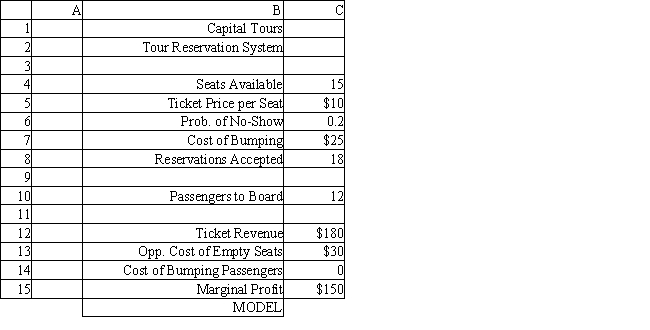Exhibit 12.4.
The following questions use the information below.
The manager of a Washington, DC sightseeing tour company is concerned about overbooking for one of his bus tours. The bus has 15 seats but sometimes there are empty seats. His records show that about 20% of ticket holders do not show up for their tour. Tickets cost $10 and are non-refundable. If the manager overbooks the tour and more than 15 passengers show up, some of them will be bumped to a later tour. This bumping costs the company $25 in various expenses to keep the customer happy until the next tour. The manager wants to see what happens to profits if 18 reservations are accepted. 
-Using the information in Exhibit 12.4, what formula should go in cell C13 of the worksheet to determine the Opportunity Cost of Empty Seats?
Definitions:
Staffing
The process of identifying, evaluating, and selecting individuals for roles within an organization, ensuring the right fit between the job and the employee.
Cognitively Diverse
Refers to a group characterized by differences in their modes of thinking, problem-solving skills, and ways of processing information.
Problem-Solving Teams
Groups formed within an organization to identify, analyze, and solve specific problems, often involving members from different departments.
Generations
Periods of time marked by distinct social, cultural, and demographic characteristics, often used to describe cohorts of people born and raised in similar timeframes.
Q10: Refer to Exhibit 9.1. Provide a rough
Q14: Dependent demand is described by a probability
Q21: An oil company wants to create lube
Q24: Refer to Exhibit 9.1. What is the
Q25: The term Late Finish refers to the
Q25: A small town wants to build
Q41: The standardized queuing system notation such as
Q44: Refer to Exhibit 11.8. What formula should
Q51: A research director must pick a
Q97: How are states of nature assigned probabilities?<br>A)